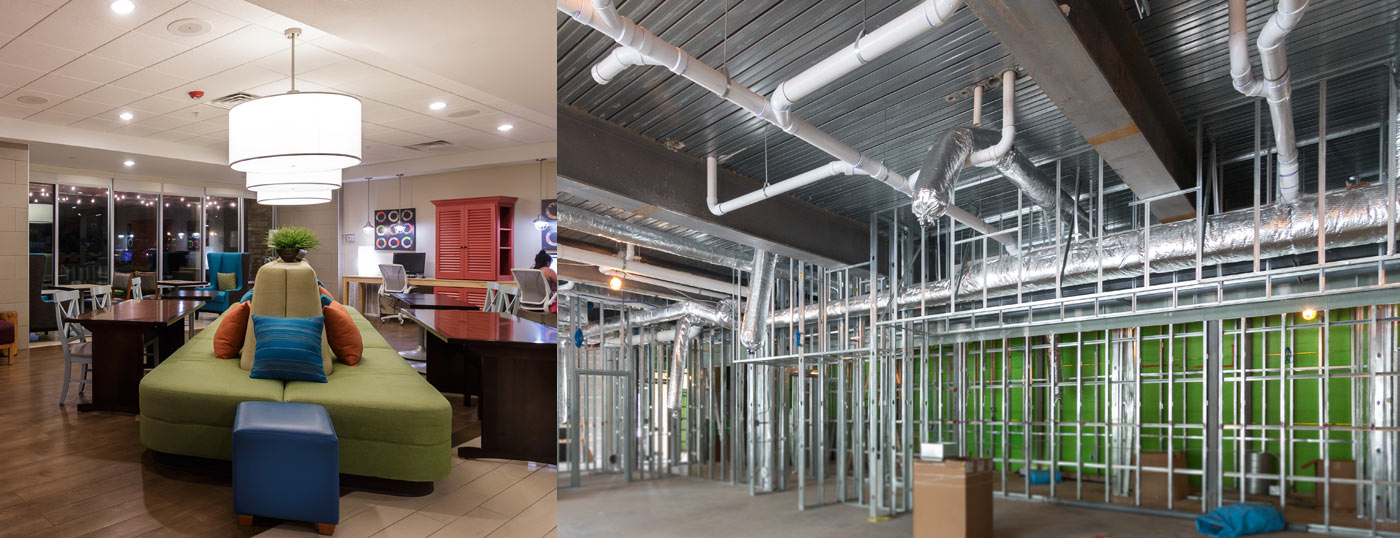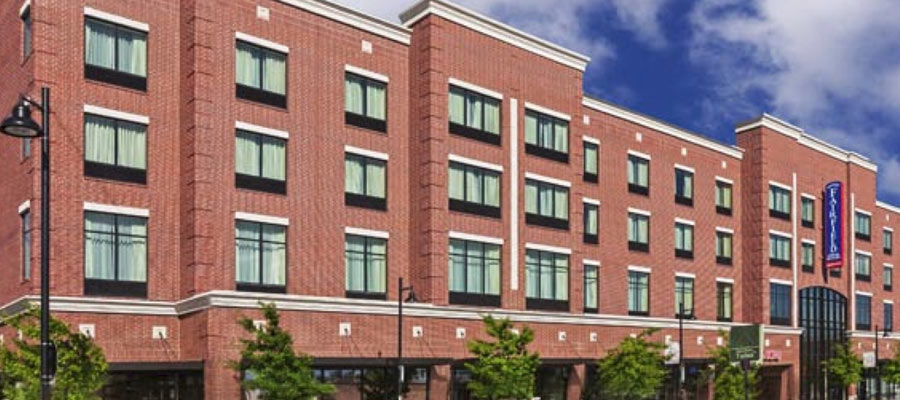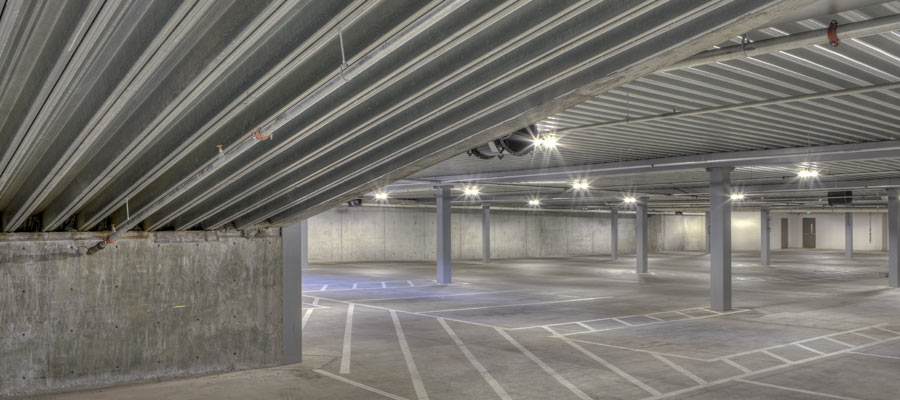
Competition is good for business. That’s what we learned in high school economics; it’s what the Federal Trade Commission preaches; and it’s the whole idea behind the board game Monopoly.
Like many industries in the age of the sharing economy, the hospitality industry is learning that lesson. The rise of Airbnb has pushed hotel owners to up their game, resulting in an explosion of improved options and experiences for consumers. From a design standpoint, that means breathtaking lobby designs, spacious guestrooms and a contemporary aesthetic. Long-span composite floor systems make those high ceilings, grand open spaces and clean looks possible while also offering efficient construction, health and safety benefits, and improved performance.
Occupant safety and comfort is paramount in hotels of all sizes, but especially in high-capacity, multi-story hotels. Long-span composite floor systems address this in two ways: sound and fire control.
Who among us hasn’t had to deal with a noisy hotel guest disrupting our sleep?
Dovetail composite deck, because of its telltale shape, naturally controls noise with its fluted cavities. Added acoustical treatments, consisting of sound insulation batts and perforated deck, contribute to noise control. Ambient noise is absorbed in the insulation and dissipates in the deck cavity.
Deep-ribbed composite deck as a base system has comparable acoustics to standard construction methods. To control sound reverberation, deep-ribbed composite acoustical is an option. In this profile, the cellular cavity is filled with acoustical batt insulation placed over lath separators. Added floor and ceiling assemblies boost the Sound Transmission Class (STC) and Impact Insulation Class (IIC) ratings so you might not hear the guests’ dance party above you.
For both deep-ribbed and dovetail composite, flooring and ceiling componentry type, arrangement and installation will influence acoustical performance. Decoupling, damping and flanking techniques should also be considered in noise-reduction strategies.
In base form, deep-ribbed composite is UL fire-rated up to two hours while dovetail composite is fire-resistance-rated up to three hours without protective coverings such as gypsum and spray-on materials. With optional treatments, deep-ribbed composite and dovetail composite can attain unprotected fire-endurance ratings of up to four hours.
Additionally, when placed over cold-formed-steel (CFS) bearing walls, dovetail composite deck is typically installed in single-span lengths with the fluted ends staggered to each side of the wall. Doing so creates a UL-approved Head-of-Wall assembly that blocks fire, smoke and sound between occupied areas.
A positive first impression is particularly key in the hospitality industry, and long-span composite deck can help achieve that.
Left exposed, long-span deck creates unique and appealing looks as it conceals unsightly side-lap and roofing fastener penetrations. Deep-ribbed composite has attractive deep-fluted ribs or a cellular option for a smooth visual ceiling effect; dovetail composite creates a clean, sleek, lineal plank aesthetic. Optional acoustic treatments give deep-ribbed composite a perforated deck panel. In addition, deck can be factory prime-painted and readied for field-applied finish paints after installation.
Beautiful and functional structures are a necessity in the hospitality industry, but equally as important is optimal use of occupied space. Long-span composite floor systems accomplish this by creating the thinnest floor depths possible, maximizing floor-to-ceiling height and minimizing overall structural height.

The long-span capacity of deep-ribbed composite deck helped achieve an open, fully convertible floor plan below the 3-story wood frame above this Fairfield Inn and Suites in Tulsa, Okla.
Many hotel features that wow guests are realized because of wide-open spaces that long-span composite systems enable. A deep-ribbed composite system can create clear spans of 36 feet (unshored concrete pours of 22 feet); dovetail composite clear spans can reach up to 28 feet. These clear span capabilities allow design teams to work with areas devoid of obtrusive load-bearing support columns or walls.
The 22-foot unshored clear spans of deep-ribbed composite paid off during the renovation of the historic Plymouth Hotel in Miami, Fla. Plans called for a new fourth floor and new roof, but shoring was not an option because of potential damage to the building’s original wood floors installed in 1940. New Millennium used a 7.5-inch deep-ribbed composite deck with 18-gage steel to clear 20-foot spans.
Dovetail composite deck creates floor depths as shallow as 4 inches without sacrificing strength. Deep-ribbed composite deck, meanwhile, has span-to-depth ratios equal to traditional cast-in-place concrete and hollow-core plank. Both systems’ low-profile slabs maximize ceiling height, allowing for design of spacious interiors such as lobbies, and reduce building height, eliminating additional materials and labor.
These floor systems can eliminate bulky mechanical, electrical and plumbing support systems that rob spaces of ceiling height.
Preset pipe sleeves, junction boxes and engineered openings help streamline MEP service installations while deck inserts and drilled-in hangers are used to suspend services below the floor. In some cases, special hanging devices that work with dovetail composite deck allow utilities to be elegantly suspended from the deck.
While building occupancy and usability as quickly as possible are important in any business, they are especially important in hospitality. Hotels are literally selling their square footage, so as soon as that is made possible, the better. Long-span composite floor systems streamline and accelerate low-rise and mid-rise construction so owners can realize guest revenue earlier.
Lightweight deck panels allow for maximum maneuverability without heavy lifting equipment. They can be placed quickly and efficiently on the structure’s frame with less manpower.
Long-span composite’s light weight and space optimization means less material required. Lightweight floors also equal a lighter structural frame. Fewer support walls or columns are needed. Drop ceilings are rendered immaterial thanks to the exposed aesthetic of long-span composite deck. Less concrete is used because of the deck’s strength.
Some long-span composite floor systems augment erection of lightweight deck with optional on-ground assembly. New Millennium deep-ribbed composite deck, for example, can be pre-assembled into panels on the ground then hoisted onto the frame using a crane. In addition to optimizing erection, this Panelized Delivery Method™ does not subject workers to dangerous heights, which can reduce insurance premiums up to 40 percent.
In addition to human occupants, hotels sometimes must accommodate vehicles in attached or adjacent parking garages. For many of the same reasons they are well-suited for multi-story hotels, long-span floor systems are attractive options for parking structures.

A deep-ribbed composite deck was used in this two-level garage that supports a two-story Homewood Suites Hotel above it in Moab, Utah.
Thin-slab floors optimize floor-to-floor and building height; clear spans can reach up to 36 feet; mechanical, electrical and plumbing services are seamlessly integrated; and weight-bearing walls or structures can be placed at optimized spans that can facilitate up to 4-stall widths.
Long-span composite floor systems use up to 40 percent less concrete than traditionally poured-in-place concrete floors and can be integrated with a wide range of structural framing. They can be erected quickly and efficiently.
As anyone who’s maneuvered a vehicle through the cramped spaces of a parking garage can attest, all the ingredients for accidents are there. Long-span composite floor systems offset some of the risk. The clear spans create clean sightlines and a more open atmosphere while the deck’s reflective coating options brighten the structure.
Building a better steel experience